What Hi-Fi? Verdict
AudioSolutions' third-generation Overture O305F offers a lively sound with incredible deep bass and exceptionally efficient delivery.
Pros
- +
Lively sound
- +
Very efficient
- +
Excellent deep bass
Cons
- -
Bi-wiring
- -
Low impedance
Why you can trust What Hi-Fi?
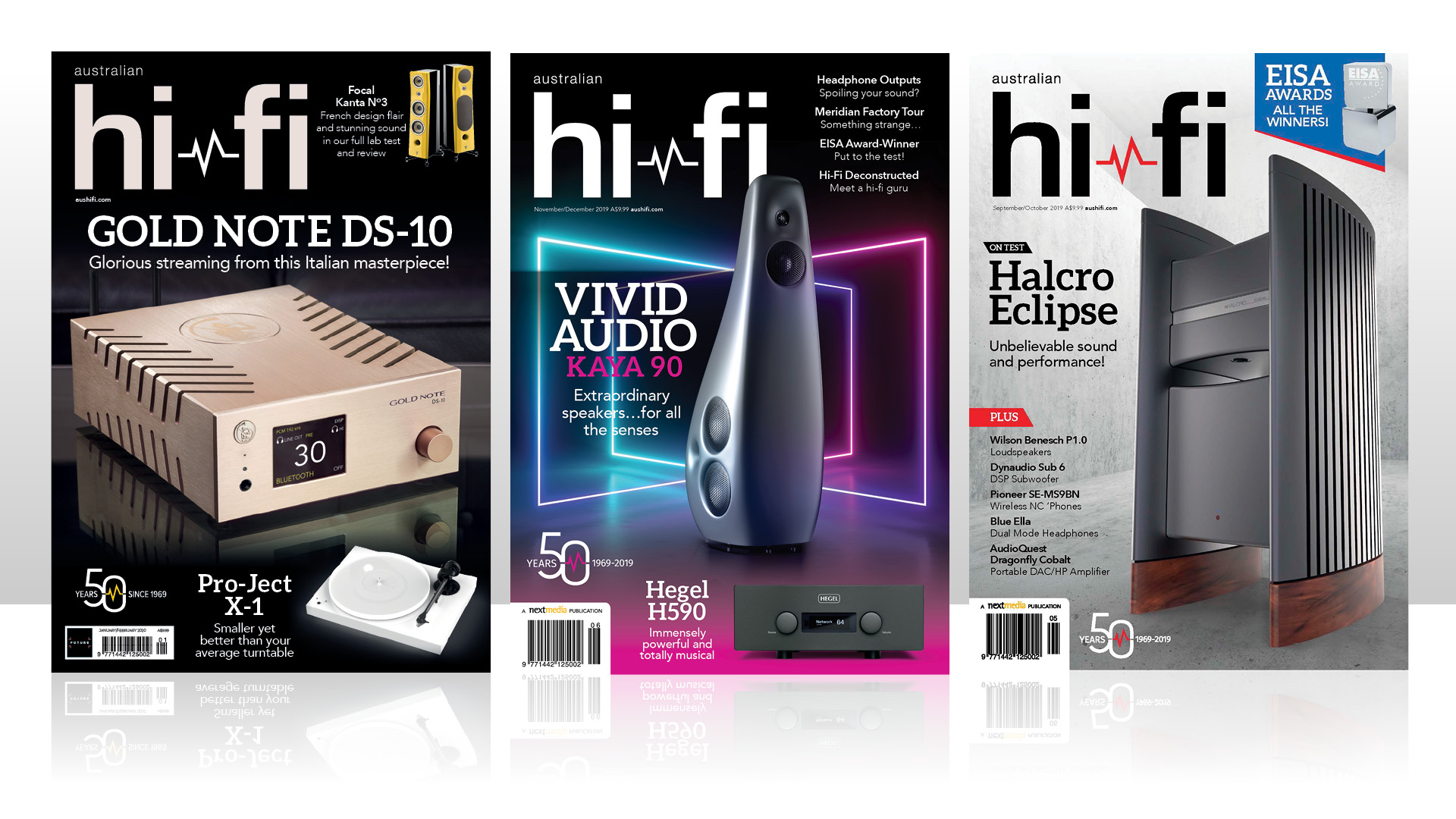
This review and test originally appeared in Australian Hi-Fi magazine, one of What Hi-Fi?’s sister titles from Down Under. Click here for more information about Australian Hi-Fi, including links to buy individual digital editions and details on how best to subscribe.
The new AudioSolutions Overture O305F is a bit like a Russian doll, despite being made in Lithuania, because it has two cabinets, one inside the other, in what founder and lead design engineer Gediminas Gaidelis calls a ‘box in a box’ design. It’s also the forerunner of a whole new series for AudioSolutions which sees all the previous O2xx designs replaced by O3xx designs, so the O305F reviewed here replaces the old O205F.
That the design is completely new is no better illustrated by fact that whereas the old O205F was a five-driver, three-way design the new O305F is, as you can see, a four-driver, three-way design.
Equipment
The tweeter is a 25mm silk dome type that Gaidelis says is custom-made for AudioSolutions by Swedish manufacturer SEAS. It’s fitted with what AudioSolutions calls a ‘mini-horn’ that has two purposes. The main one is to reduce distortion at high volume levels which occurs when the mass of air in front of the peak of the dome becomes sufficient to prevent it moving as fast as the sides of the dome.
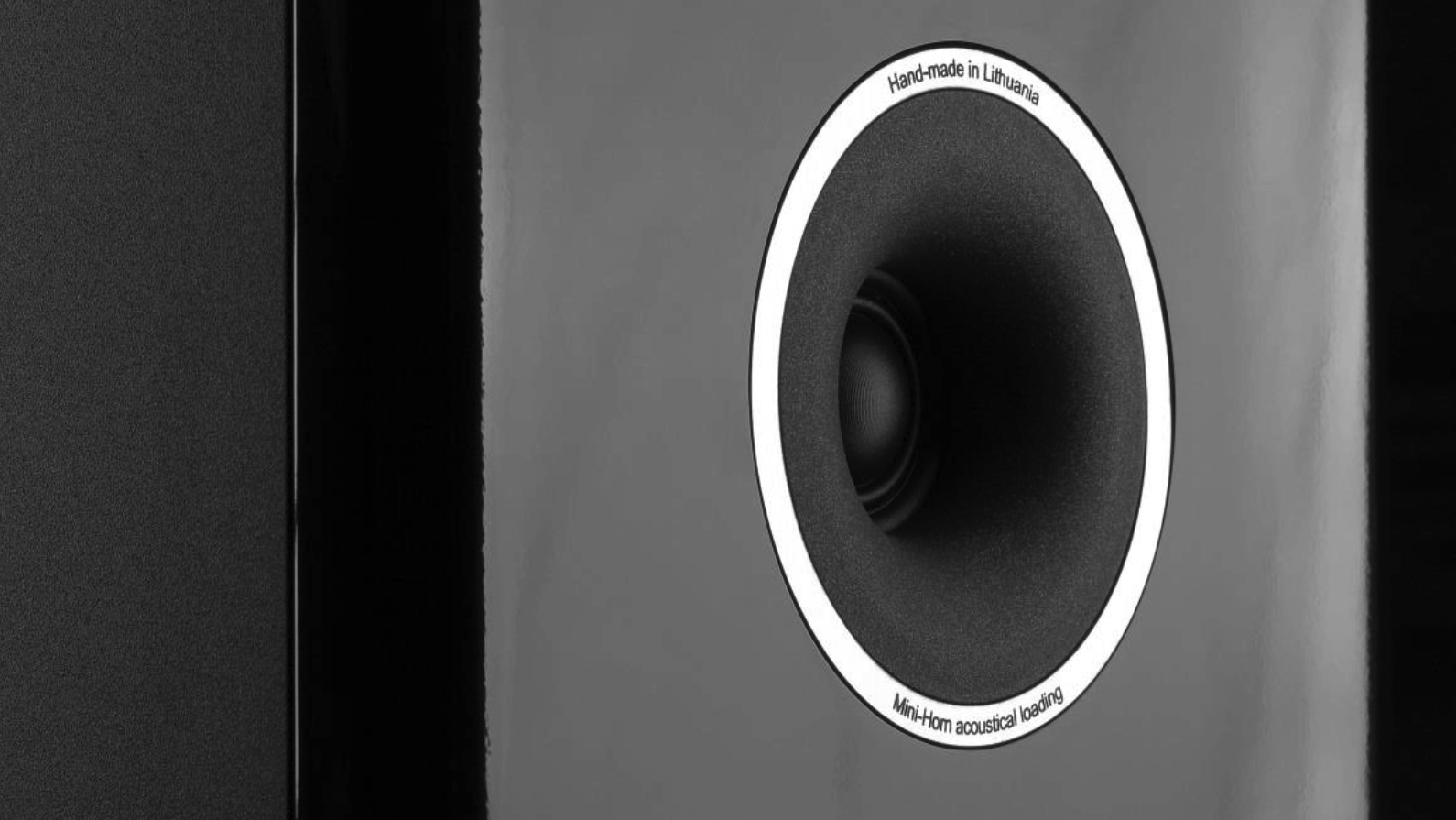
This is a problem solved in various different ways by different manufacturers. A common one is to attach the peak of the dome to a ‘bridge’ spanning the tweeter, or simply to damp the peak using a similar bridge method.
Gaidelis says that although both these techniques are effective, they’re very expensive solutions, because it’s so difficult to ensure that electrical and acoustical parameters do not differ between samples. He says his ‘mini-horn’ solution achieves the same result, with the added advantage that it effectively increases the efficiency of the tweeter, so it doesn’t have to work as hard to produce the same sound pressure levels as it would without the horn-loading.
You can see that the O305F uses a fairly unusual ‘inverted’ driver array, where the tweeter is mounted below the midrange driver. On the O305F this is done partially to avoid the high-frequency flutter echoes that can occur when a tweeter is close to a ceiling, partially to reduce time delay over the operating bandwidth and partially to ensure that the tweeter was positioned closer to the ear level of a seated listener.
Midrange frequencies between 500Hz and 3kHz are handled by a single 152mm paper-coned midrange driver that Gaidelis says is custom-made for AudioSolutions by SB Acoustics, a division of Malaysian company Sinar Baja Electric. The paper used to make the cone is what AudioSolutions calls an ER or ‘Extra Rigid’ formulation. Although they’re manufactured in Malaysia, all SB Acoustic drivers are designed by Ulrik Schmidt and Frank Neilsen of Danesian Audio in Denmark, a company founded by the pair after leaving their previous employers (Scanspeak and Tymphany).
As for the O305F having a single driver dedicated to producing midrange signals, it is very important (to the point of being essential) for any true hi-fi loudspeaker to use one because of an effect that I once used to call Doppler Distortion but I now call Phase Modulation Distortion, thanks to the work of people far more experienced in technology than me (notably Rod Elliott, Siegfried Linkwitz and Art Ludwig).
Phase modulation occurs when a single speaker cone is called upon to reproduce low and high frequencies simultaneously, which is what happens in any two-way loudspeaker.
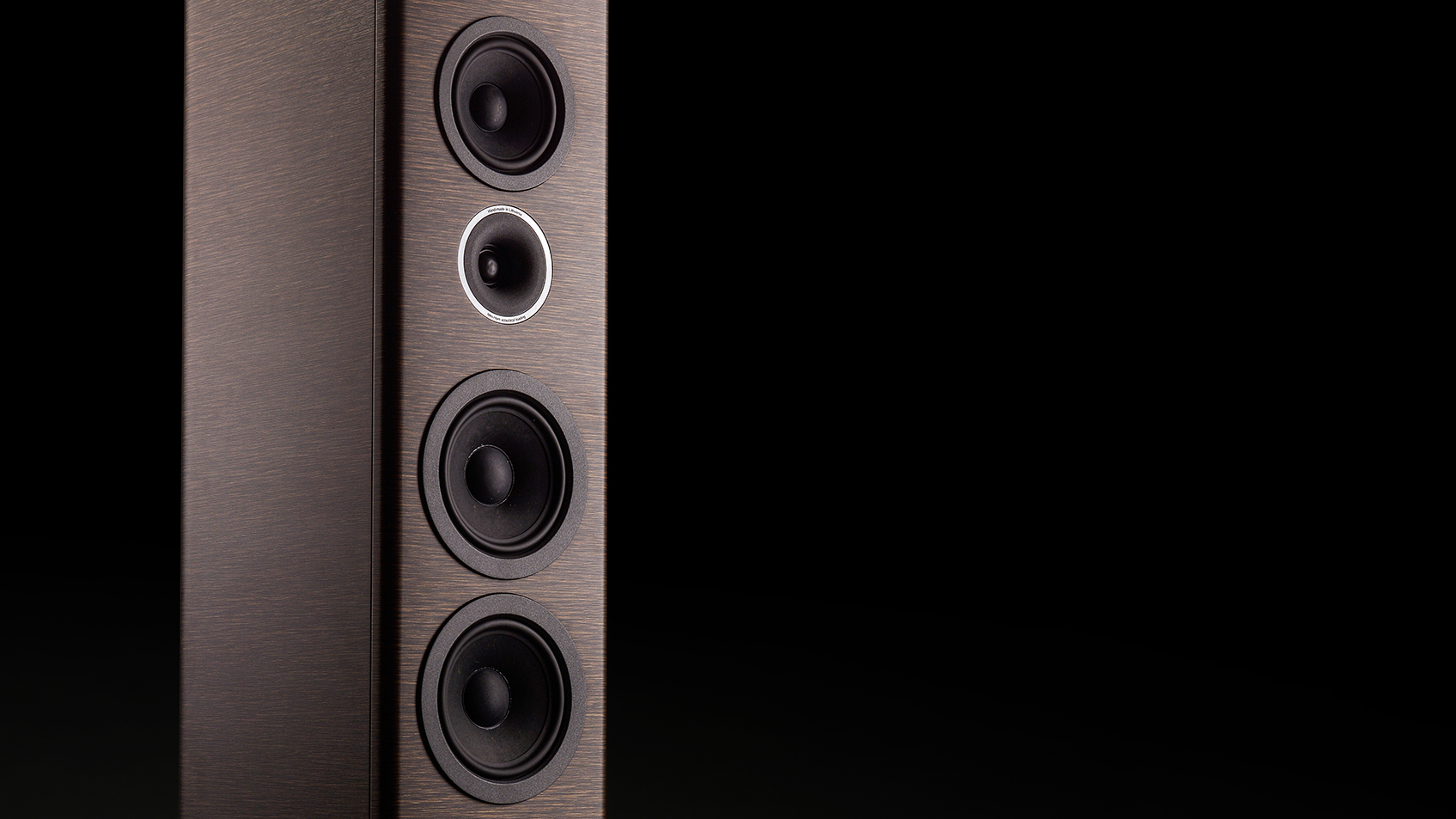
If a driver is required to produce a single low-frequency sound (at, let us say 55Hz), its cone will move backwards and forwards fifty-five times per second and your ear would hear the resulting movement of air caused by this movement as the musical note ‘A1’. This pitch is an octave above the lowest A on a piano keyboard and also the one to which the second string of a double-bass is tuned. So far so good.
But if that same driver is also asked to produce another musical note, let us say middle-C, which has a frequency of 261.63Hz, it would have to move backwards and forwards 261.63 times per second at the same time that it’s also moving backwards and forwards 55 times per second. This means the frequency of what should be ‘middle-C’ will actually not always be precisely 261.63Hz but will be shifted higher or lower depending on the direction the cone is moving as a result of having to produce the 55Hz signal at the same time.
It’s because of phase modulation distortion (PMD) that it’s preferable that a low frequency driver (or drivers) be used to produce low frequencies and for a completely separate loudspeaker to be used to produce midrange frequencies. (I would advise anyone interested in this type of distortion to read the article Doppler distortion in loudspeakers – Real or Imaginary? by Rod Elliott, in which he not only discusses and explains phase modulation distortion, but demonstrates the effect by measuring it on a loudspeaker.)
Low frequencies are handled by two ‘ER’ paper-coned drivers with diameters of 183mm, both of which were also designed by Danesian Audio and manufactured by SB Acoustic. The drivers are operated in parallel, which is primarily the reason for the O305F’s relatively low impedance, which AudioSolutions rates as being ‘nominally 4Ω.’
Using two drivers increases the efficiency of the design, enables a higher power-handling capability (because amplifier power is distributed over two voice-coils, rather than just the one) and, most importantly, means the cones can move more air, which improves the realism of the bass. The low-bass output also gets an assist by virtue of a rear-firing bass-reflex port.
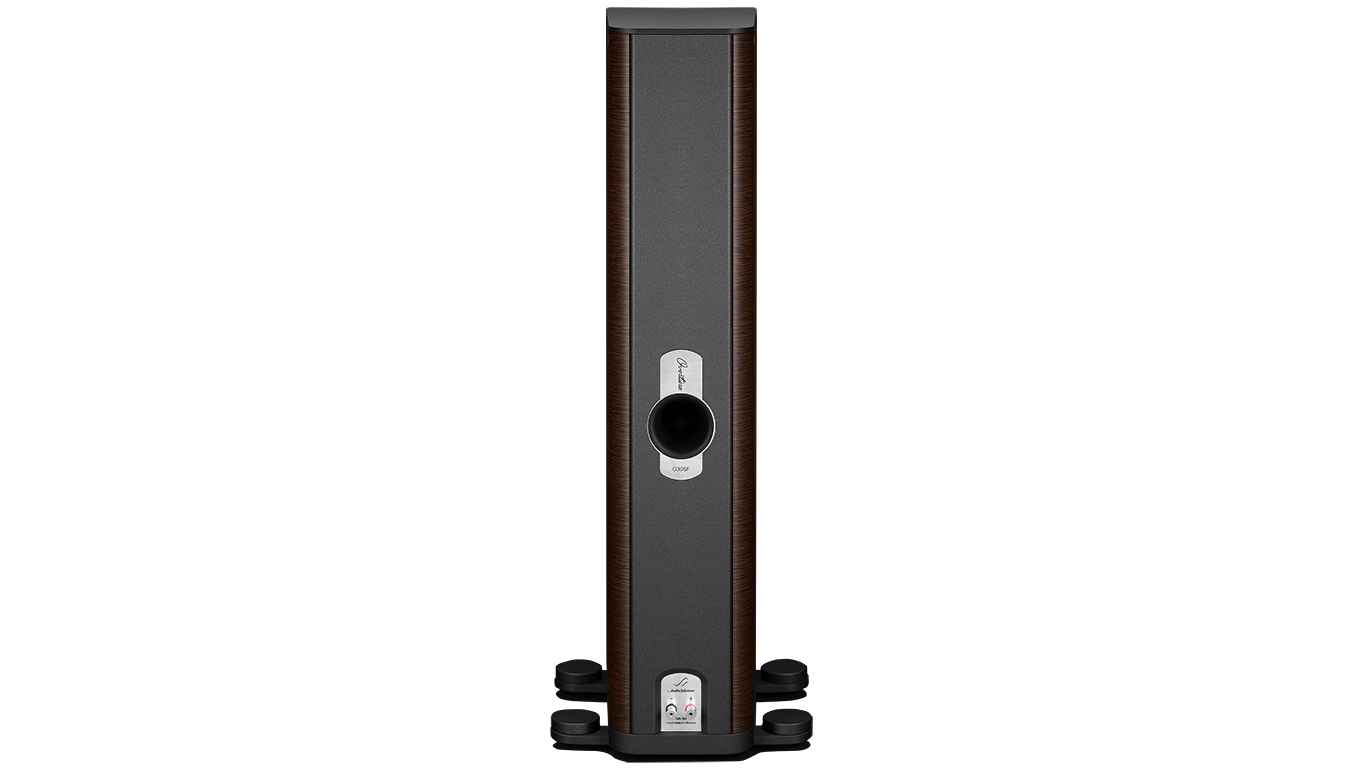
The speaker terminals on the new O305F benefit from having been upgraded from the ones on the previous model to large multi-way types finished in frosted satin silver, which AudioSolutions says “can take even thickest high-end cable manufactured today” (obviously having not seen the cables we manufacture here in Australia!) “and provide proper grip for tightening and most importantly, a proper path for signal travel without any losses.”
Internally, the terminals are connected to the drivers via heavy-duty wire and a phase-linear crossover whose printed circuit board has extra-thick copper traces and uses high-grade air-cored inductors.
The O305F stands 1.11 metres tall on its ‘outrigger-style’ stand which in turn stands on four carpet-piercing M6-threaded spikes. For users who have a solid floor of some type (timber, granite, tile…) AudioSolutions provides protective caps so the spikes can’t mark the surface.
The fact that a standard M6 thread is used means you can substitute feet from other manufacturers if you wish. You will, however, have to use the outrigger stand because the O305 is so tall and narrow that it’s quite unstable without the stand fitted.
Your choice of cabinet finish will affect the price you have to pay for a pair of O305Fs. The standard finish is a painted baffle in white or black both with charcoal sides. If you’d prefer a real wood finish, you can optionally choose between three species – Oak, Mahogany and Wenge – but doing so will add AU$1,780 (about £940 / $1,280) to the asking price.
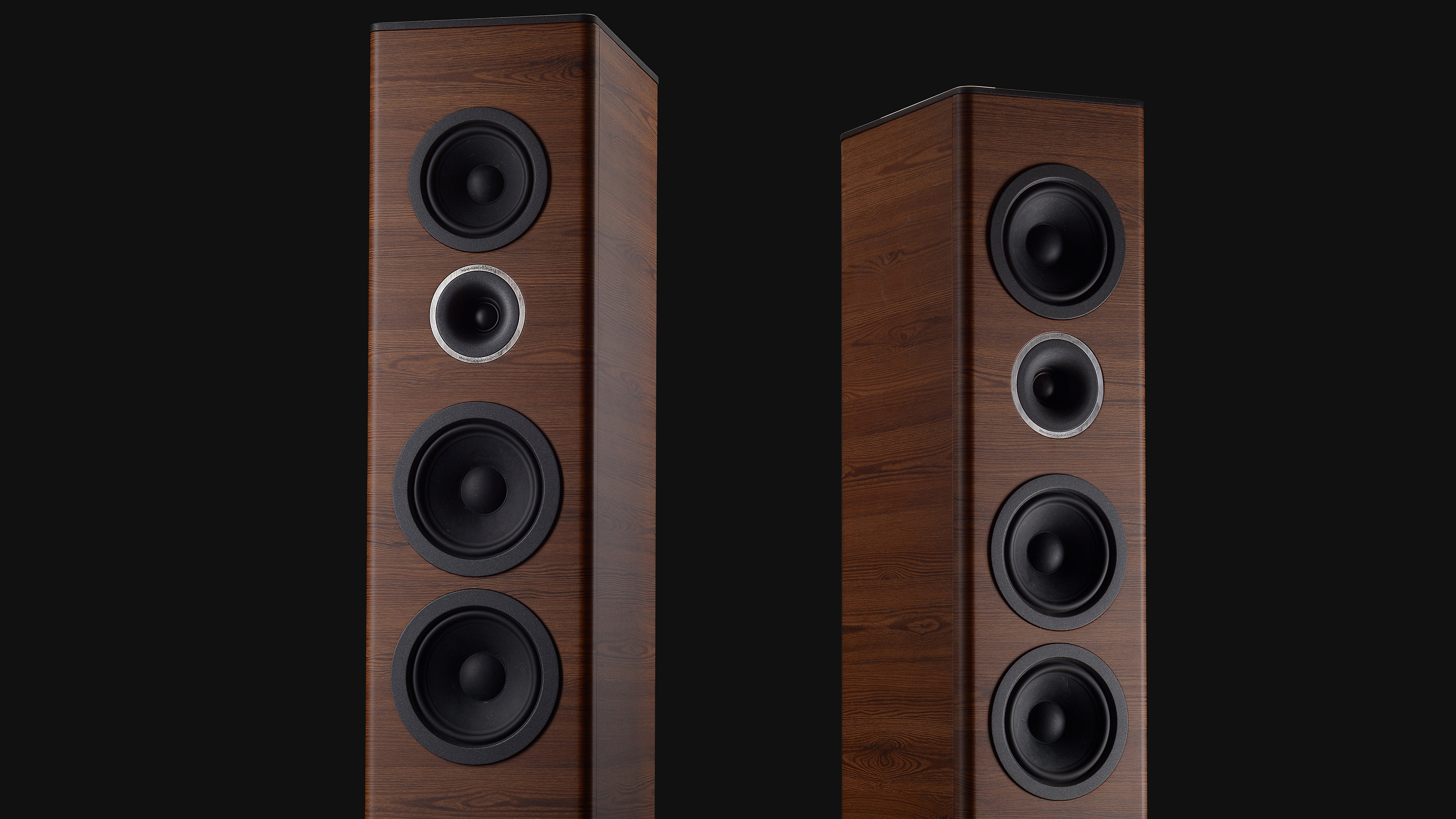
The speaker prices include a nice set of grilles that attach magnetically, so no fixings will show on the baffle if you prefer your speakers ‘naked’. (Don’t underestimate this inclusion, an increasing number of – in my opinion misguided – speaker manufacturers are either not providing grilles for their speakers at all, or charging extra for them.)
Box-in-a-box design
Gaidelis originally developed his ‘box in a box’ cabinet design for AudioSolutions’s more expensive Virtuoso series, but with this new 03xx series, he decided to trickle-down the technology to improve performance. The box-in-a-box design comprises two independent structures, a lightweight inner cabinet and a heavier, outer one.
Between the two is a very thin layer of polyurethane, which Gaidelis says acts as dampening material. “The thin but stiff inner cabinet provides the necessary support for the structure itself as well as transfers the energy of radiated back-wave to the outer cabinet layers without storing energy inside the material and preventing the back-wave from being reflected to the listener,” says Gaidelis. “Fast energy transfer is essential in order to prevent low-Q oscillations which can last relatively long and ruin precise sound reproduction.”
Gaidelis says that in order for the box-in-a-box technology to work it is essential that the two ‘boxes’ be separated by the thin (less than a millimetre thick) layer of polyurethane. “The polyurethane layer not only acts as an additional barrier for energy to be dissipated into heat while travelling from the inner box to the outer box but also helps the outer high-mass box to quickly stop its movement,” he says. “To illustrate its working principle you should imagine a child’s swing being suddenly stopped with the help of a soft pillow.”
Listening
The rear-firing bass reflex port means that the low-frequency sound of the O305Fs will be more dependent on the cabinets’ proximity to a rear wall (and the material of which that wall is constructed) than a bass reflex design with a front-firing port, or a sealed enclosure, so some room positioning experimentation will be required, possibly a bit more than is the norm.
However, optimum placement will pay off, because when you attain that position, you’ll find that the bass extension of the new O305F is impressive, with the speakers digging deep into the bottom-most octave, and delivering solid, tight and tuneful bass right up to where those twin bass drivers hand over to the midrange driver.
Listen to the O305Fs and you’ll be left in no doubt that designer Gediminas Gaidelis has a very clear and coherent concept of how he wants his designs to sound, because despite the enormous differences in the sizes of the cabinets, and the complete change of manufacturer for the bass driver, and the difference in the number of drivers used I thought that the O305F’s tonal character was uncannily similar to that of AudioSolutions’ previous-generation O202B design, despite the latter being a small two-way standmount design.
I personally found this similarity in sound to be immensely reassuring, because if speakers from the same manufacturer sound completely different, the designer obviously has no idea of how music should sound!
When I am reviewing loudspeakers, I normally try to single out the strongest point of that speaker’s performance to focus on it, and highlight it as the focal point of my review. With the AudioSolutions O305F, however, I was not able to do that, because their performance was so strong across so many important areas.
So let’s start with the most important, which is the midrange, because that’s where the human ear is most sensitive and most discriminating, so if a speaker does not deliver realistic midrange sound, it really doesn’t matter if it has great bass and superlative treble.
I am happy to report that the midrange of the O305F is outstandingly good, being pure, clean and well-balanced and with no distortion that I could hear. I wasn’t overly surprised, mind you, because most of these benefits will be delivered by a well-designed three-way loudspeaker system that’s using a high-quality midrange driver. Nonetheless, I was still impressed by the O305F’s midrange delivery because of its very melodic quality. It just sounds totally musical and super-easy on the ears.
Using female vocalists to test midrange sounds like a cliché, but it’s really no more than using snow to test snow-skis. And how many female vocalists are out there in the ‘top ten’ of any genre you care to mention? Listening to female vocalists will be a major part of your day-to-day listening, so you want it to be good.
k.d. lang’s gorgeous mezzo-soprano voice is always a good place to start for me, but I’m not really a fan of her own compositions, so my go-to album of hers is always ‘Hymns of the 59th Parallel’, where she covers songs made famous by other Canadian musicians, including Neil Young, Joni Mitchell and Leonard Cohen. (OK, it does include one song she wrote, but it was a co-write with David Piltch and it’s my least favourite song on the album.)
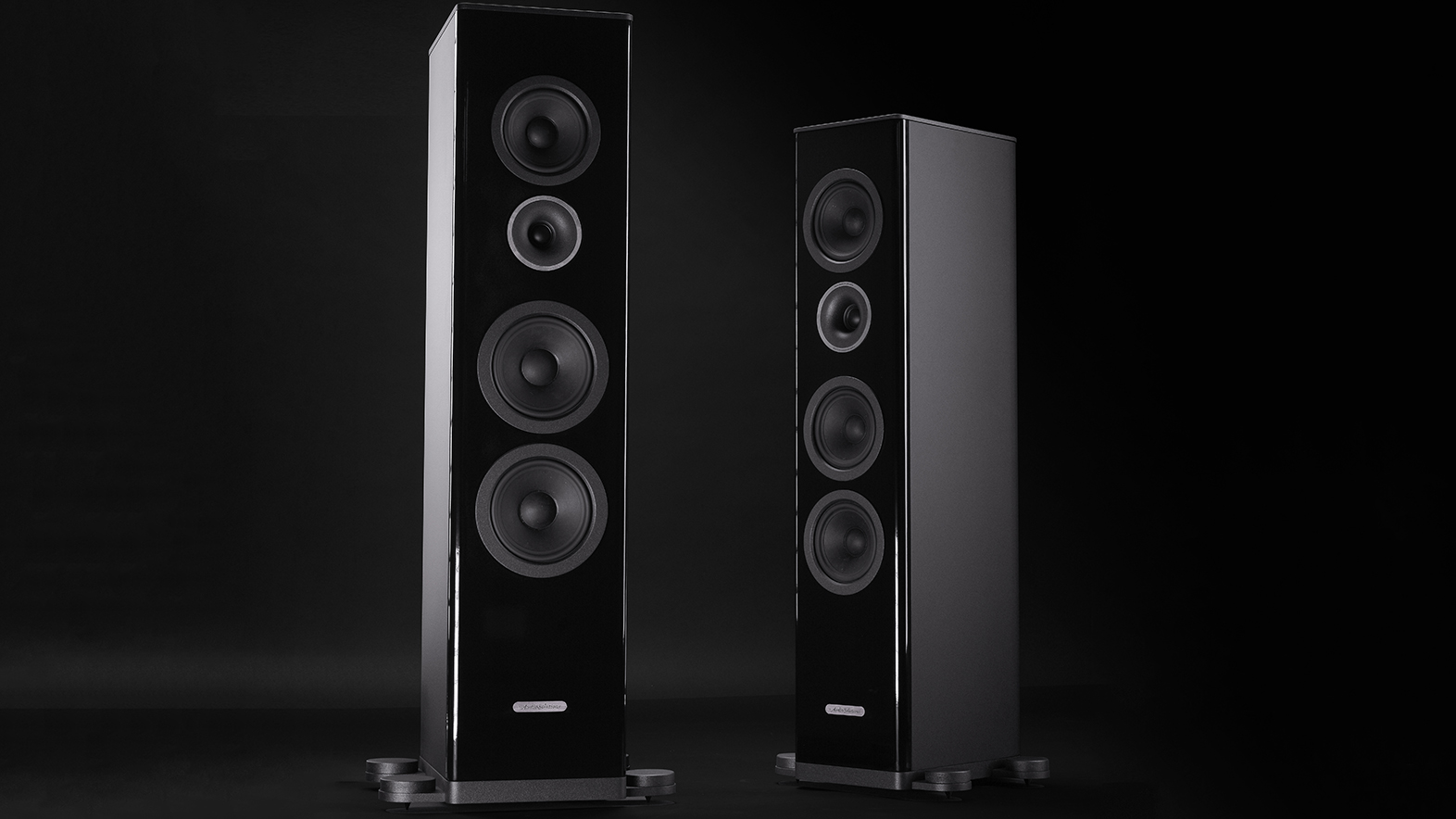
Just as an aside, I was going to mention that David Piltch was once the bassist for Blood Sweat and Tears, but since almost every bassist in the US has played for Blood Sweat and Tears at one time or the other, this wouldn’t exactly be overly informative. OK, so writing ‘every bassist’ in that sentence was an exaggeration, but they’ve had 15 bass players so far, including the current one, Ric Fierabracci. (At least he was at the time of writing!)
If you listen to lang’s versions of Neil Young’s Helpless (Track 1) or A Case of You (Track 3), you will never listen to any other versions of it. She interprets these songs beautifully, with an out-of-this-world cadence that just throbs of heart-ache. When she sings “something about a queen” the AudioSolutions O305Fs delivered the turn of her voice on the word ‘queen’ like few other speakers are capable. And later, when she sings “floating on the breeze” the vibrato she adds to the word “breeze” is again delivered by the O305Fs so clearly, so articulately, and so pitch-perfectly that you’ll be pinching yourself at the perfection of it all. This is sound quality at its very finest.
This revelatory sound quality does come at a cost, because listening to the O305Fs was the very first time I have ever noticed that when Lang sings “there was a band playing in my head / and I felt like getting high” she sings the word “getting” just a little flat. Such is the price of high fidelity, I guess.
My first test for bass was with those two fathers of dub techno, Moritz von Oswald and Mark Ernestus. Their track Mango Drive at first listen sounds repetitive, but if you listen closely and your speakers’ bass delivery is sufficiently revealing you’ll be able to hear that the seemingly repetitive bass is actually being altered slowly and subtly as the track progresses. I was able to hear this when listening to the AudioSolutions 0305Fs, plus at the same time the cleanliness of the midrange and high-frequency stabs and reverberations were also revealed. Great performance from the Lithuanian pair.
Next up was the soundtrack to one of my favourite modern science fiction movies, ‘Inception’, created by the same director who created one of my all-time favourite movies, ‘Momento’. It’s reported that composer Hans Zimmer wrote the music while watching the movie (or at least only after watching the movie) and it’s certainly very brooding and ethereal, well-suited to the film, though I find it more than a little reminiscent of the atmospherics Vangelis created for Scott Ridley’s epic movie ‘Bladerunner’. (Zimmer says the score is multiple elements of parts from Édith Piaf’s “Non, je ne regrette rien”).
Whatever the genesis of the soundtrack, there’s massive amounts of deep and not-so-deep bass and all of it was reproduced wonderfully well by the 0305Fs. The clarity of the AudioSolutions’ bass delivery made it easy to hear and appreciate the subtle changes in pitch and intonation in the bass. The ability of a speaker to do this is essential to enable the mystery of the work’s best-known track, Time, but it’s also crucial for what’s probably my favourite track, which is the earlier Dream is Collapsing. Marvellous stuff!
One of my test tracks for high-frequencies is Laurie Anderson’s ‘Big Science’ (the remaster) because the synthesisers on it are absolutely out of this world, particularly on its most popular track, O Superman. But it’s just as good for lots of other evaluations, not least because on most tracks, and particularly the introductory From The Air, we get to hear Anderson speaking, so there are multiple opportunities to evaluate the clarity and audibility of the diction against a huge variety of background sounds.
In my opinion, the ability of the O305Fs to deliver exactly the sound of her voice in all these circumstances was exemplary. The title track that follows has her singing as well as speaking and her breathy vocals were extraordinarily-well realised by the AudioSolutions speakers. The background percussion in this track is precise and the way the speakers delivered the sound of the ‘bounce’ of the skin on the drums was a joy for me. Rarely do I hear this done so well.
I also use another of Anderson’s albums (‘Songs from the Bardo’) to evaluate a loudspeakers’ reproduction of the sound of violin, cello and piano but also for a quiet contemplation of death, because on this album (which I admit is not for the faint of heart) Anderson reads passages translated from ‘The Tibetan Book of the Dead’ (‘The Bardo Thodol’) aided by musical accompaniment from Tibetan singer and musician Tenzin Choegyal (he plays the dranyen, a Tibetan stringed instrument, and Tibetan singing bowls), Rubin Kodhel (cello) and Jesse Paris Smith (piano). The sound of the bowl singing is perfectly resonant and the O305F reveals the pitch pulsing in concert with the pulsing volume.
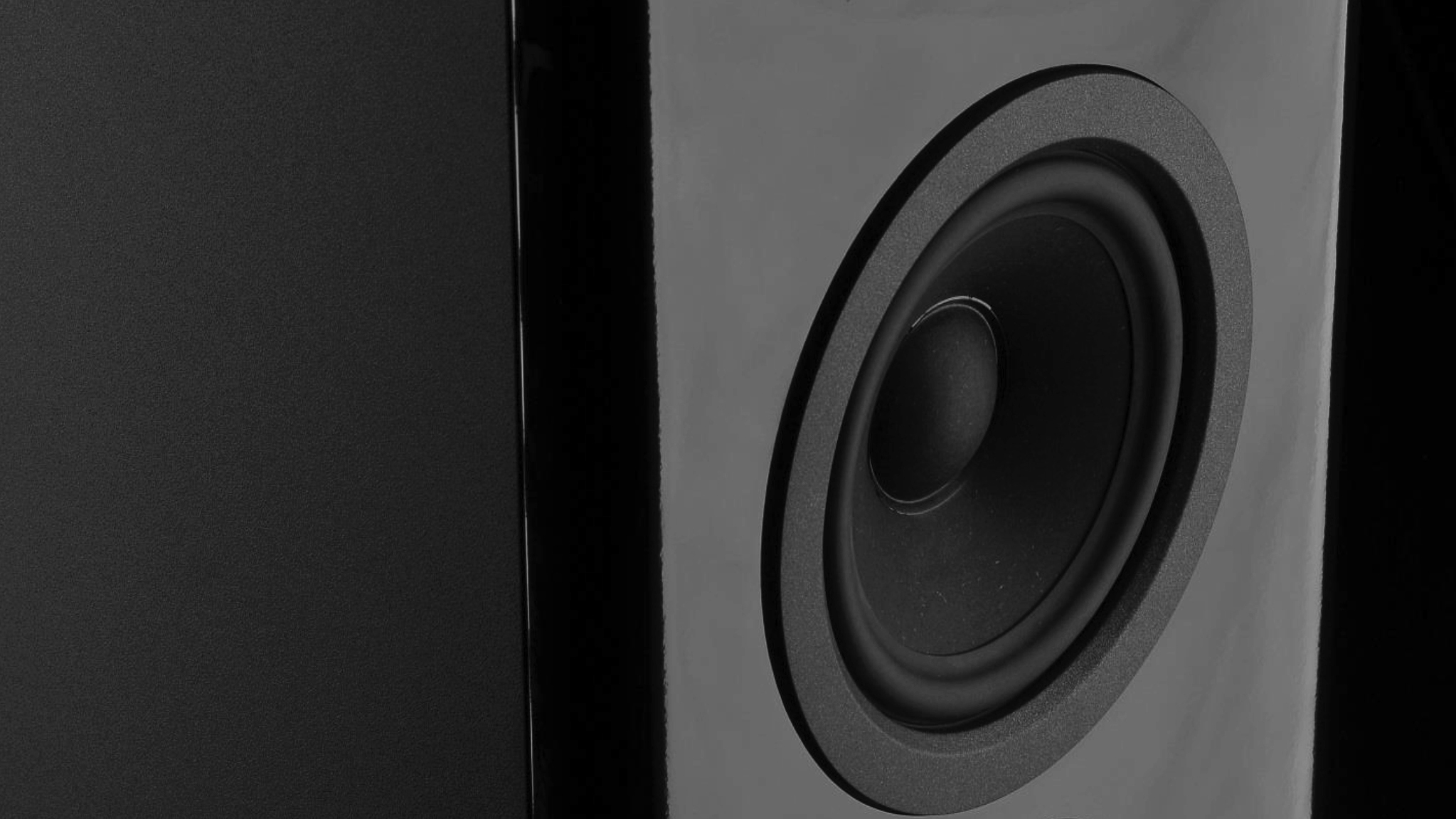
I thought I’d better finish this review with a more ‘fun’ album, so it was time for what’s likely the best album so far for the year, which is Olivia Rodrigo’s ‘Sour’. If you’ve been put off this album by listening to Drivers Licence, which is the track that gets the most airplay, forget that one and make a point of listening to the entire album, because Good 4 u is a stunning track, as are Traitor and Brutal both. I’d add Déjà vu to these three except that Rodrigo’s taken a leaf from Billie Eilish’s play book and included some horrible distortions on it that make it a difficult listen.
What’s most impressive when you listen to ‘Sour’ is that when the album delivers power and drama, the AudioSolutions O305F delivers that power and drama, but when it switches to ‘soft and girly’ the O305F also moves straight into ‘soft and girly’, so becoming a perfect mirror to the music.
Final verdict
To reprise those final words from that previous paragraph, “mirror to the music” is a fitting way to describe this superlative third-generation design from Gediminas Gaidelis, whose signature sound is writ large in the O305F’s acoustic DNA.
Whatever speakers you thought you might be looking for for your own listening room, you owe it to yourself to audition this new model from AudioSolutions.
Detailed lab test results
Newport Test Labs evaluated the overall frequency response of the AudioSolutions O305F loudspeakers by combining an in-room low-frequency measurement with a gated (anechoic) measurement and the result is shown in Graph 1.
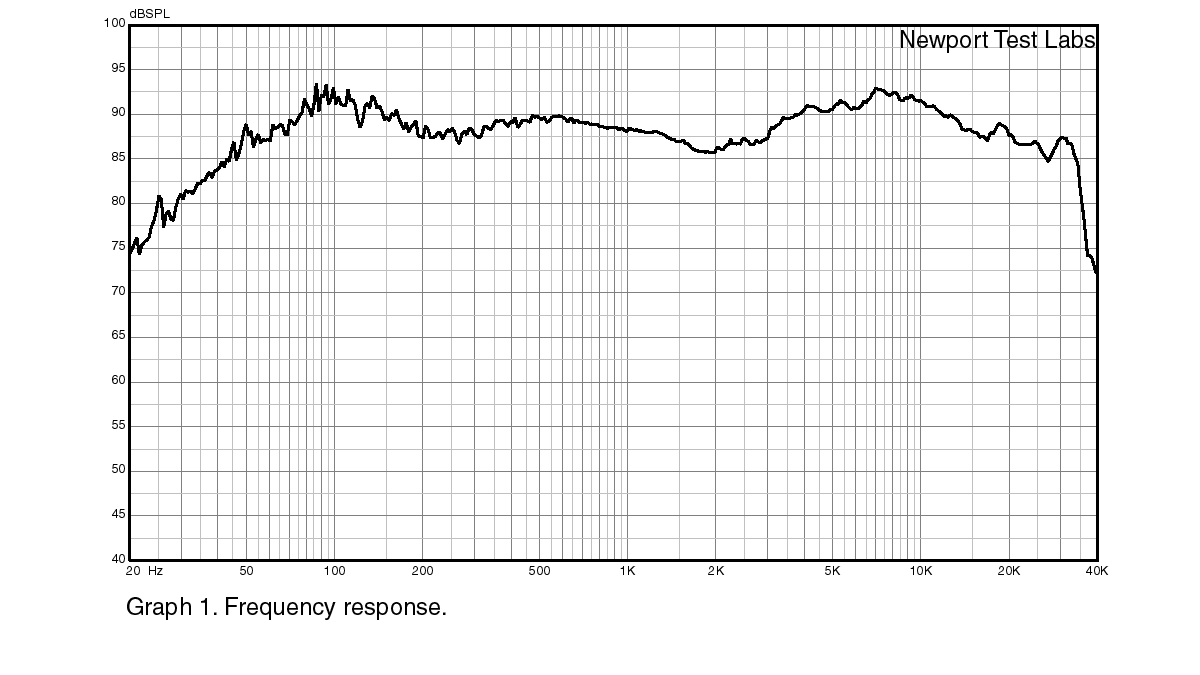
You can see that the response remains very comfortably within an 8dB envelope from 44Hz up to 34kHz, which is excellent, so the normalised frequency response measured by the lab was 44Hz to 34kHz ±4dB. This represents excellent frequency extension at both ends of the audio spectrum and excellent linearity.
You can see from Graph 1 that the response is not spectrally tilted at all, which is excellent, but also that there are very slight lifts in the response between 70Hz and 150Hz and again between 4kHz and 14kHz which are responsible for the ±4dB envelope. Were it not for these slight excursions, the frequency response would have been 44Hz to 34kHz ±3dB, which would have been outstandingly good, rather than just excellent. These lifts, along with the slight suck-out in the response centred at 2kHz would give the sound of the speaker a distinctive characteristic for a trained listener.

The effect of using a grille on the AudioSolutions O305F is shown in Graph 2, where the black trace shows the response without the grille fitted and the green trace the response with it on. You can see that the grille is almost totally acoustically transparent, so you will hear exactly the same sound balance irrespective of whether you use the speakers with or without the grilles. This is excellent design work by AudioSolutions’ design team.
Yes, there are some tiny discrepancies, particularly at 4.6kHz and at 24kHz, but these are so high in frequency and affect so little of the bandwidth that they would not be audible, even to a trained listener in a direct A–B comparison.
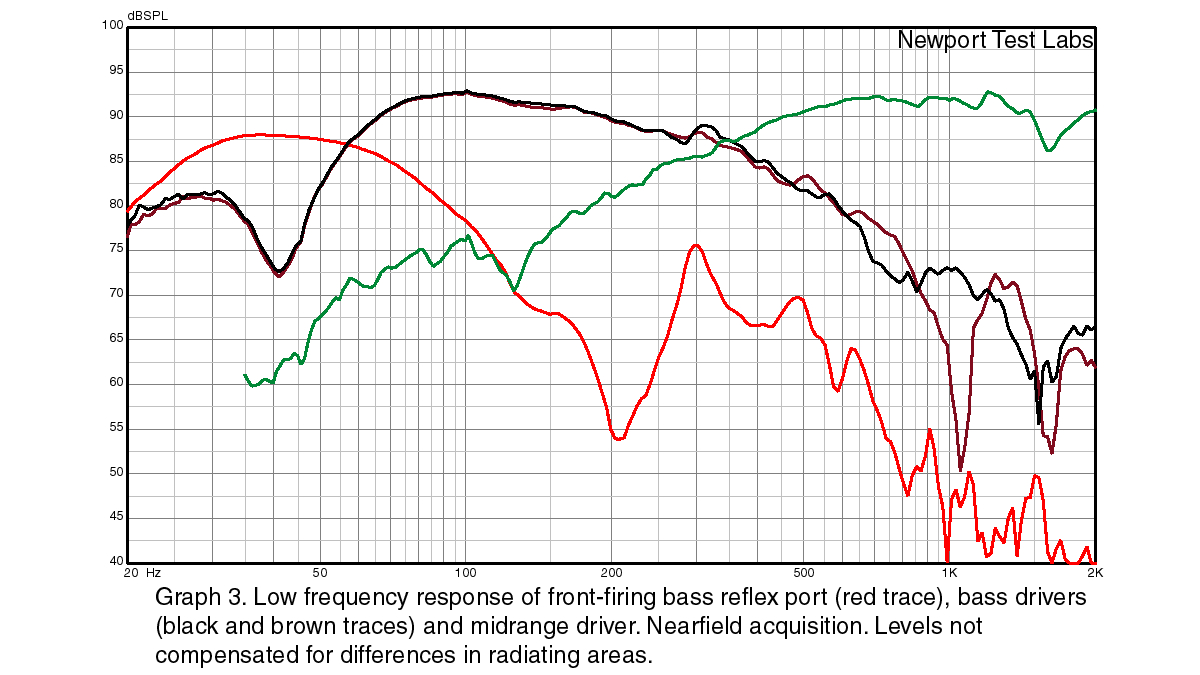
Graph 3 shows the near-field responses for the rear-firing bass reflex port, the two bass drivers and the midrange driver. This measurement technique is not particularly suited to a midrange driver, but Newport Test Labs has included it here because it shows that AudioSolutions has decided to simplify the crossover network either by letting the midrange driver’s response roll off naturally, or use a very shallow 6dB/octave slope, which would seem to account for the lift in the on-axis response around 70–150Hz noted previously.
The port delivers low frequencies over a wider bandwidth than I might have expected, so the tuning is a little unusual. The port rolls off nicely to 200Hz, but as you can see, there’s considerable energy coming out of it at 300Hz which is leakage from the rear of the bass driver cones. You can see that despite being identical, the output of the two bass drivers diverges at 450Hz, with a substantial difference just above 1kHz which is due to the differences in their location on the baffle.
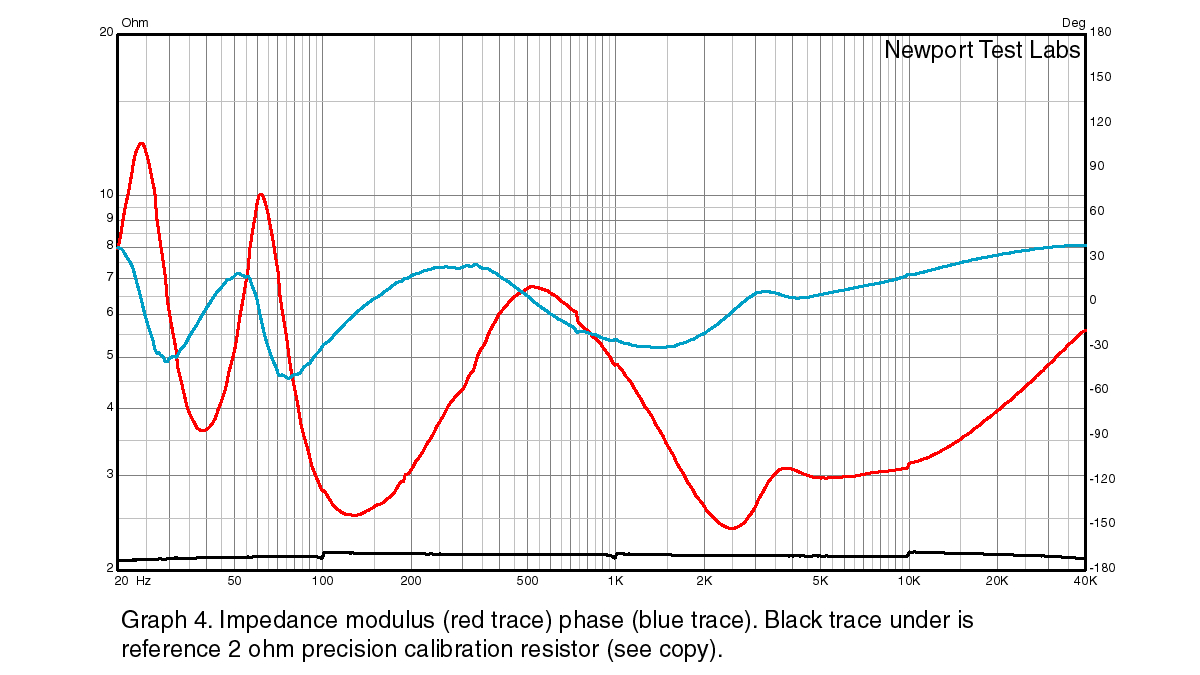
The impedance of the AudioSolutions O305F shown by the red trace in Graph 4 is overall so low that if it is indeed representative it would be a stretch to call this design a 4Ω one, as AudioSolutions has done, even if it’s qualified by the word “nominally.”
You can see that the impedance is below 5Ω from 75Hz to 30kHz except for a small rise between 350Hz and 950Hz where it almost manages to peak at 7Ω. It drops below 3Ω between 95Hz and 200Hz, and again is essentially less than 3Ω from around 1.7kHz up to 7kHz. At around 130Hz it’s around 2.4Ω and at 3kHz it’s closer to 2.3Ω. This means the speaker will demand quite some current from the driving amplifier, though it’s not a ‘difficult’ load as such, because the phase angle (represented by the light blue trace) at both these extremes is less than –15°.
Note that because the measurement set-up used is not totally accurate at very low impedances, Newport Test Labs has included a measurement of a precision 2Ω resistor (the black trace at the bottom of the graph) to show that the 2Ω graphing line is actually a little lower than 2Ω, so you’d need to take this into account when looking at the O305F’s impedance values in relation to the graphing calibration values.
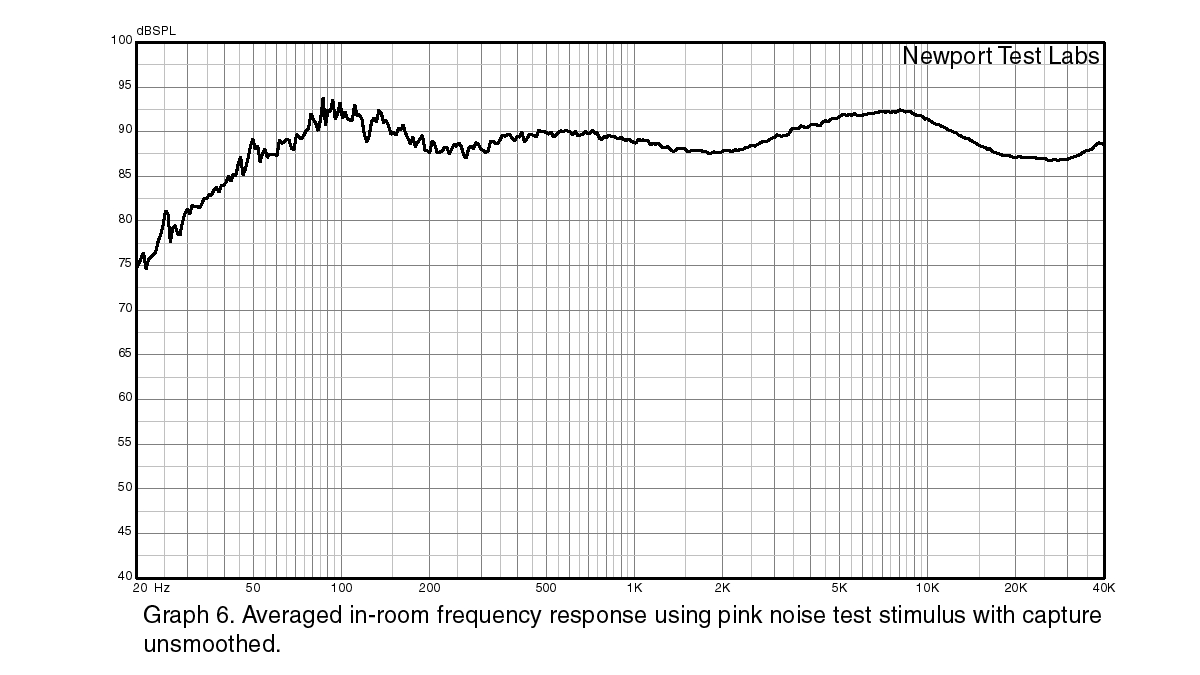
Graph 5 shows the averaged in-room frequency response of the AudioSolutions O305F when using pink noise and you can see that the response above 600Hz is rather less ‘lumpy’ than in Graph 1, and this is the response that would be perceived by the human ear. Of course below 600Hz, the graph is identical to that shown in Graph 1.
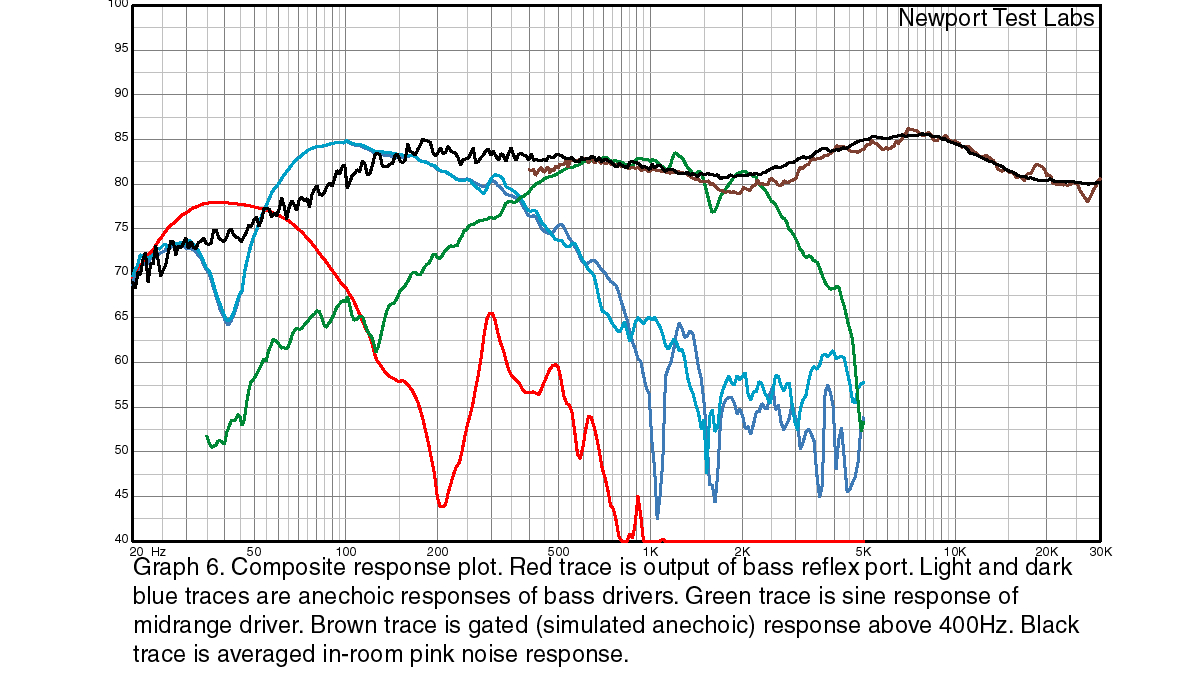
Graph 6 is a composite plot where Newport Test Labs has overlaid the various response plots so you can see the ‘fit’ between the different measurement techniques used to create the various graphs. This also shows more exactly how the in-room response at high frequencies is smoother than the anechoic response.
AudioSolutions rates the sensitivity of the O305F design at 91dBSPL at one metre for a 2.83V input. Newport Test Labs does not use quite the same measurement technique as the Lithuanian company, but the result it obtained using its standard measurement methodology was remarkably similar, at 90.5dBSPL for 2.83Veq. This makes the O305F a very efficient loudspeaker that will be able to produce very high sound pressure levels with only a minimum amount of amplifier power. However, given the low impedance of that design, it would have to be high-quality amplifier power.
The AudioSolutions O305F is a very well-designed loudspeaker that has a linear and extended frequency response and proved to be a highly efficient design – more efficient than most, in fact – in Newport Test Labs’ acoustical testing assessments.

